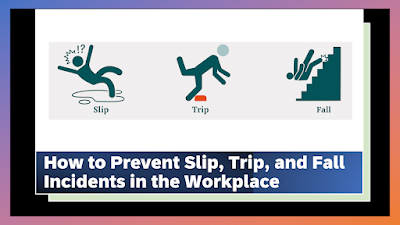How to Prevent Slip, Trip, and Fall Incidents
in the Workplace
In any industry the slip, trip, and fall incidents are some of the most common types of workplace incidents that can lead to serious injuries. These incidents can occur in any workplace in the shop floor, from offices to construction sites. Both employer and employee has to take proactive steps to prevent these incidents from occurring. In this article, we will discuss some effective ways to prevent slip, trip, and fall incidents in the workplace.
Industrial Workplace Safety | Slip Trip Fall
Maintain the Workplace Clean and Tidy
Good workplace is a safer workplace, one of the easiest ways to prevent slip, trip, and fall incidents is to keep the workplace clean and tidy. This means ensuring that all floors, walkways, and stairs are free from clutter, spills, and debris. Regular cleaning and maintenance of the workplace should be carried out to ensure that there are no hazards that could cause an incident. Employees should maintain a healthy habits of maintaining the workplace in a safer manner and should clutter in the workplace.
Adequate Lighting in the Workplace
Providing adequate lighting in the workplace can help employees see any hazards and avoid incidents. Poor lighting can be a major cause of slip, trip, and fall incidents in the workplace. It is important to ensure that all areas of the workplace are well-lit, especially stairways and walkways.
Hazardous Area Classification (HAC)
Providing Handrails and Guardrails with Toe Board
Handrails and guardrails with toe board can provide important support and protection to employees, especially on stairways and elevated areas. It is important to ensure that handrails and guardrails are installed properly and are in good condition to prevent incidents. The periodic inspection by the competent person to be done.
Use Non-Slip Mats
Non-slip mats can
provide added traction and grip on slippery surfaces, such as in kitchens &
canteen dining areas or bathrooms. These mats should be placed in areas where
spills or wet floors are common. Non-slip mats can help prevent slip and fall incidents
by providing additional traction and grip.
Wear Appropriate Footwear
The industry should select the appropriate footwear. Proper footwear can help prevent slip, trip, and fall incidents. Employees should wear shoes that are slip-resistant and provide good support. Shoes with smooth soles or high heels should be avoided, as they can increase the risk of slipping or tripping.
Providing Training to Employees on Safe Practices
Providing training to
employees on safe practices is important in preventing slip, trip, and fall incidents.
Employees should be trained on how to identify hazards and how to properly use
equipment and machinery. Employees should also be trained on how to properly
walk on slippery or uneven surfaces, how to use handrails and guardrails, and
how to safely climb ladders and stairs.
Conduct Regular Inspections
Regular inspections of the workplace can help identify potential hazards and prevent incidents. Inspections should be conducted regularly by the competent employees to ensure that floors, walkways, and stairs are in good condition and free from hazards. Any hazards that are identified should be addressed immediately to prevent incidents.
Post Warning Signs
Posting warning signs
in areas where hazards are present can help prevent incidents. Signs should be
visible and easily readable and should warn employees of potential hazards.
Examples of warning signs include "wet floor," "slippery
surface," and "uneven surface." The signs should meet the standard
requirements.
Use Proper Lifting Techniques
Improper lifting techniques can lead to serious back injuries and other incidents. Employees should be trained on how to properly lift and carry heavy objects and should be provided with lifting equipment when necessary. Lifting equipment, such as dollies or carts, can help prevent incidents and injuries. Manual handling to be avoided as much possible and mechanical aids to be used for handling the materials.
Encourage Employees to Speak Up
Encouraging employees
to speak up about potential hazards can help prevent incidents. The
motivational programs will help for reporting more incidents and rectification.
Employees should feel comfortable reporting any hazards they identify and
should be assured that their concerns will be addressed. Employers should
create an open and supportive culture where employees feel empowered to speak
up about safety concerns.
It is important to note that preventing slip, trip, and fall incidents is not only important for the safety and well-being of employees but can also benefit employers in the long run. By creating a safe and healthy work environment, employers can reduce the risk of workplace incidents and injuries, which can result in reduced worker's compensation claims, increased productivity, and decreased absenteeism.
In addition to the above mentioned measures, employers can also consider implementing a workplace safety program. A workplace safety program can help ensure that all employees are aware of the potential hazards and are trained on how to prevent incidents. The program can also include regular safety meetings, hazard assessments, and incident reporting procedures.
Safety Signage | Safety Signs | Safety Poster
Conclusion
Slip,
trip, and fall incidents can be prevented by taking proactive steps to ensure a
safe workplace. Employers and employees should work together to identify and
address potential hazards and should prioritize safety in all aspects of their
work. By keeping the workplace clean and tidy, providing proper lighting,
installing handrails and guardrails, using non-slip mats, wearing appropriate
footwear, training employees on safe practices, conducting regular inspections,
posting warning signs, using proper lifting techniques, and encouraging
employees to speak up, slip, trip, and fall incidents can be significantly
reduced or even eliminated.

No comments:
Post a Comment